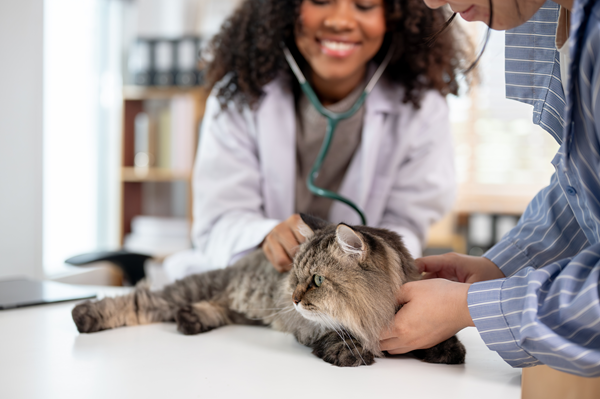
Whether your cat is the “stoic and silent” type or the full-throttle banshee on four paws, National Take Your Cat to the Vet Day is your annual reminder that vet visits are more than a necessary evil: they’re literally a lifeline, adding years to your cat’s life.
So how do you get your cat into a carrier without losing a limb? What magic beans (i.e., pre-visit meds) can calm the chaos? And why is your very cool, very independent cat pretending to be perfectly healthy when in fact they’re hiding dental disease behind those whiskers?
Why are regular checkups important?
Cats are masters of disguise. They’ll hide illness until the last possible moment – usually Friday afternoon before your planned holiday! Regular exams help catch issues like kidney disease, dental trouble, or early arthritis before your cat looks sick.
- Staying one step ahead with prevention. Vaccinations, parasite checks, microchip scans, and weight reviews are all part of preventive care. Preventive care works like insurance, except the payout is fewer unexpected vet visits.
- Peace of mind for you, too. Nothing says “I love you” quite like knowing your buddy’s health is stable.
- Secret signs are real signs. Vet pros pick up on tiny changes – like slowing down or mild dehydration – that the rest of us would only call “fluffy behavior.”
How can I get my cat ready (without hairballs of stress)?
Vet visits can be…challenging, to say the least. But a little planning can turn anxiety into an almost enjoyable outing.
- The Carrier is Not a Trap: It’s a Zen Den. Leave that carrier out – with a cozy blanket, favorite toy, maybe a spritz of synthetic feline pheromone – so your cat sees it as a napping nook, not a trap. Even better, try feeding treats or meals inside it.
- Short Practice Drives. Pop your cat into the comfy carrier and take a quick spin around the block. Make it two or three times. No drama, lots of snacks. Soon, the car becomes “uber to tuna,” not “looming terror.”
- Calm Vibes = Happy Cat. Cats absorb your energy. Keep calm, talk softly, or even sing – whatever floats their kitty boat.
How can “pre-visit pharmaceuticals” (PVPs) help?
Medication doesn’t rob your cat of personality; it can gently press the “chill” button so the vet can do their thing without the claws coming out.
- Gabapentin and trazodone are classic crowd-pleasers. They help tamp down anxiety and can even reduce the dose of additional sedation, if needed.
- The newer star is pregabalin, which is like gabapentin’s more focused, longer-lasting cousin. It’s designed especially to help with vet-visit anxiety in cats, at safe doses, with minimal sedation.
These meds are part of a multimodal approach, so pair them with carrier conditioning, calm environments, and a friendly vet team to make your cat’s trip as smooth as a freshly groomed fur coat.
But remember these medications are always vet-prescribed and dosed. And timing matters. Usually, your cat will need them a few hours before their visit, so check with your vet. Dosing recommendations can be very specific to each cat, so your vet may recommend a “trial dose” at home to ensure there is just the right effect.
Get Ready for Friday
Here’s your mini mission (if you choose to accept it):
- Carriers out and comfy. May the treats be many.
- Schedule that visit – especially if you’ve been delaying because “he seems fine.”
- Consider discussing PVPs with your vet. For anxious cats, it’s like giving them an emotional cushion.
- Celebrate after: Brag to social media about how great your cat was – thanks to your preparation! Your cat might judge you, but in a loving, partially aloof cat way.
